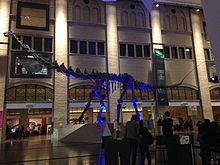Futalognkosaurus
| Futalognkosaurus Temporal range: Late Cretaceous,
| |
|---|---|

| |
| Mounted replica skeleton, Royal Ontario Museum | |
| Scientific classification | |
| Domain: | Eukaryota |
| Kingdom: | Animalia |
| Phylum: | Chordata |
| Clade: | Dinosauria |
| Clade: | Saurischia |
| Clade: | †Sauropodomorpha |
| Clade: | †Sauropoda |
| Clade: | †Macronaria |
| Clade: | †Titanosauria |
| Clade: | †Lognkosauria |
| Genus: | †Futalognkosaurus Calvo et al., 2007 |
| Type species | |
| Futalognkosaurus dukei Calvo et al., 2007
| |
Futalognkosaurus (/ˌfuːtəˌlɒŋkoʊˈsɔːrəs/ FOO-tə-long-ko-SAW-rəs;[1] meaning "giant chief lizard") is a genus of titanosaurian dinosaur. The herbivorous[2] Futalognkosaurus lived approximately 87 million years ago in the Portezuelo Formation, in what is now Argentina, of the Coniacian stage of the late Cretaceous Period. The fish and fossilized leaf debris on the site, together with other dinosaur remains, suggest a warm tropical climate in Patagonia during this period.
Description


The holotype of the type species, Futalognkosaurus dukei, was originally estimated at 32–34 metres (105–112 ft) in length.[3] In 2008 this was down-sized to 26 metres (85 ft).[4] In 2012 Holtz estimated it at 28 metres (92 ft) long and with an approximate weight of 43.5-51 tonnes (48-56 short tons).[5][6] An estimate by Gregory S. Paul in 2016 was that Futalognkosaurus had a maximum length of 30 metres (98 ft) and a weight of 50+ tonnes (55 short tons) .[7] In 2016, using equations that estimate body mass based on the circumference of the humerus and femur of quadrupedal animals, it was given an estimated weight of 38.1 tonnes (42 short tons).[8] In 2019 Paul estimated the weight of the holotype specimen, (MUCPv-323) at 29 tonnes (32 short tons).[9] Its long neck contained 14 vertebrae, and was over a meter deep in places, due to its extremely tall neural spines which had a distinctive "shark-fin" shape. The hips were also extremely large and bulky, reaching a width of nearly 3 metres (9.8 ft).[10] The alternate early spelling "Futalongkosaurus" may be found in some press reports and on websites.
Discovery
Its fossils were found in the Neuquén province of Argentina in 2000, and were scientifically described in 2007. The genus name is derived from the local indigenous language Mapudungun and is pronounced foo-ta-logn-koh-sohr-us: "futa" means "giant" and "lognko" means "chief".[3] It is based on three fossil specimens, yielding an estimated 70% of the skeleton in total. The fossil team described the find as "the most complete giant dinosaur known so far".
Classification
In their phylogenetic analysis, Calvo and colleagues found Futalognkosaurus to be a member of the Titanosauridae (or Lithostrotia, depending on the definitions being used), and most closely related to Mendozasaurus. They defined a new clade for the group containing both Futalognkosaurus and Mendozasaurus, their common ancestor, and all descendants, which they named the Lognkosauria.[3] The authors found Malawisaurus to be the sister group of this new clade. Another, much later member of Lognkosauria is the colossal Puertasaurus,[11] which may be the biggest dinosaur so far known. Besides Futalognkosaurus, other fauna was discovered in the Futalognko site, including two further undescribed sauropod taxa, specimens of Megaraptor, Unenlagia and some pleurodiran turtles.


The following cladogram shows the placement of Futalognkosaurus among Titanosauria:[3]
| Titanosauria |
| ||||||||||||||||||||||||
References
- ^ AP Pronunciation Guide D–K[dead link]
- ^ Pellim, Roberto (2007-10-19). "Nieuwe dinosoort". Metro (in Dutch). p. 7.
- ^ a b c d Calvo, J.O., Porfiri, J.D., González-Riga, B.J., and Kellner, A.W. (2007) "A new Cretaceous terrestrial ecosystem from Gondwana with the description of a new sauropod dinosaur". Anais da Academia Brasileira de Ciências, 79(3): 529-41.[1]
- ^ Calvo, J.O.; Juárez Valieri, R.D. & Porfiri, J.D. 2008. Re-sizing giants: estimation of body length of Futalognkosaurus dukei and implications for giant titanosaurian sauropods. 3° Congreso Latinoamericano de Paleontología de Vertebrados. Neuquén, Argentina.
- ^ Holtz, Thomas R. Jr. (2008) Dinosaurs: The Most Complete, Up-to-Date Encyclopedia for Dinosaur Lovers of All Ages Supplementary Information
- ^ Hotlz, Thomas R. (2014). "Supplementary Information to Dinosaurs: The Most Complete, Up-to-Date Encyclopedia for Dinosaur Lovers of All Ages".
{{cite web}}: CS1 maint: url-status (link) - ^ Paul, G.S., 2016, The Princeton Field Guide to Dinosaurs, 2nd Edn, p. 233, Princeton University Press
- ^ González Riga, Bernardo J.; Lamanna, Matthew C.; Ortiz David, Leonardo D.; Calvo, Jorge O.; Coria, Juan P. (2016). "A gigantic new dinosaur from Argentina and the evolution of the sauropod hind foot". Scientific Reports. 6: 19165. Bibcode:2016NatSR...619165G. doi:10.1038/srep19165. ISSN 2045-2322. PMC 4725985. PMID 26777391.
- ^ Paul, Gregory S. (2019). "Determining the largest known land animal: A critical comparison of differing methods for restoring the volume and mass of extinct animals" (PDF). Annals of the Carnegie Museum. 85 (4): 335–358.
- ^ "Futalognkosaurus was one big-ass sauropod". 2009-10-20.
- ^ Calvo, J. O.; Porfiri, J. D.; González Riga, B. J.; Kellner, A. W. A. (2007). "Anatomy of Futalognkosaurus dukei Calvo, Porfiri, González Riga, & Kellner, 2007 (Dinosauria, Titanosauridae) from the Neuquen Group, Late Cretaceous, Patagonia, Argentina". Arquivos do Museu Nacional. 65 (4): 511–526.
External links
- Dinosaur Mailing List entry which discusses the genus
- Fósiles hallados en el Centro Paleontológico Lago Barreales - contains images of Futalognkosaurus (in Spanish)
- BBC Report of Monday, 15 October 2007 - includes a photo of some of the dinosaur's bones, attributed to National Museum of Brazil.
- Illustration of Futalognkosaurus by paleoartist Julius T. Csotonyi












